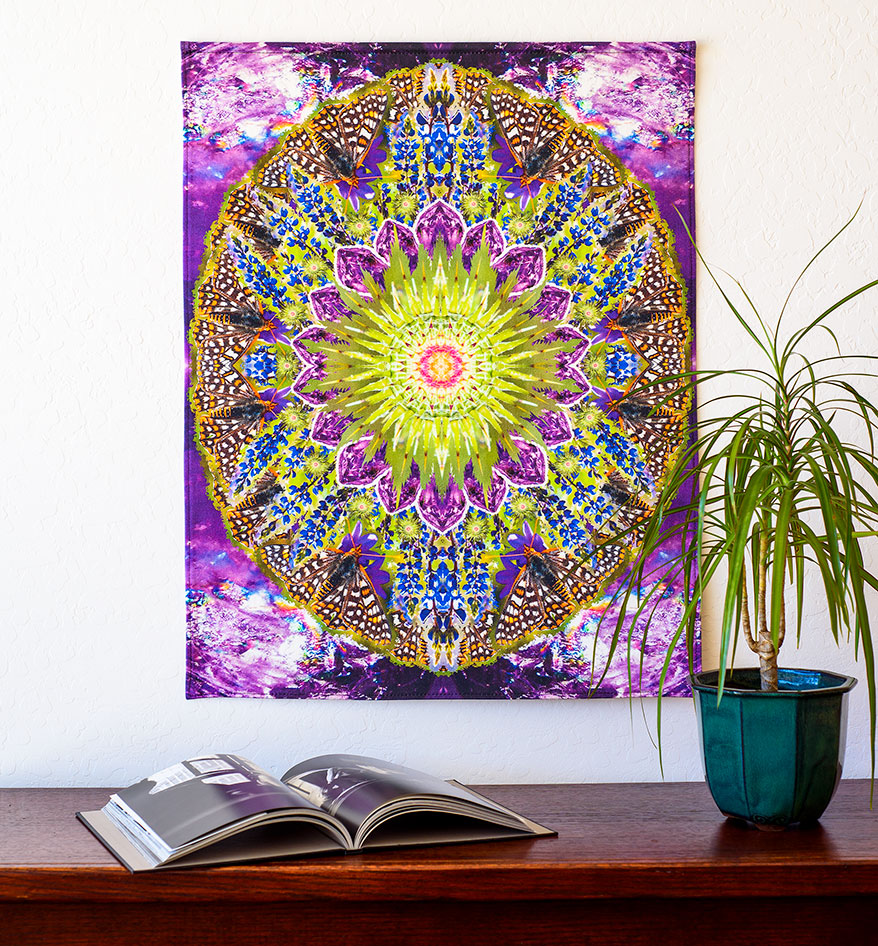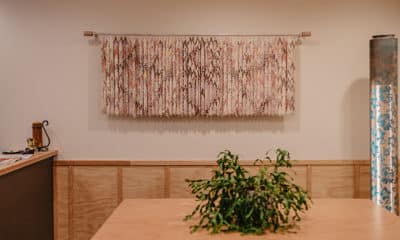
Asher Sinclaire
THROUGHOUT MY YEARS in the digital textile printing industry I’ve had the privilege of meeting diverse individuals from all over the world. While our personal paths to the tradeshow floors are all unique, I’ve noticed an amusing pattern. Most of us didn’t take a straight road to digital printing, but rather stumbled our way into this cutting-edge and creative industry. It seems we’ve all taken delight in our own discovery of how powerful these technologies pose to be. Whether looking through the lens of customization, technological innovation, bringing manufacturing back to the USA, or something altogether different, many of us identify digital printing as a catalyst that has propelled us into unchartered territories. That’s certainly the case for Arizona-based digital eco-artist, Asher Sinclaire (ashersinclaire.wixsite.com/asher). His foray into digital printing is as interesting of a journey as they come.
Fueled by a relentless passion and commitment to sustainability, and a need to connect technology and nature, Sinclaire’s research-driven path should make us all pause and take note.
Growing up in the Sonoran Desert to two creative educators, it’s no wonder Sinclaire found himself – and his research – at the crux of art, technology, and environmentalism. An award-winning photographer and educator himself, Sinclaire began tiptoeing toward digital printing methods in the mid 2000s. He was first introduced to printing digitally on ceramic tiles, but the poor color-to-lightfastness results prevented him from continuing with the process.
With his interest piqued and emboldened to find alternative and functional photographic processes, he began experimenting with digitally printed textiles.
Sinclaire’s approach to digital printing technology has always been rooted in his fine art background and ambition to infuse the natural world with our daily lives. Digital printing simply acts as his tool of expression. Starting with the debut of his photographic design, “Rotation Transformation,” which won the Black Mountain Conservancy Photo Contest, Sinclaire’s signature freeform collage technique represents the fullest abilities of the technology. Some could argue that his work epitomizes the digital print medium.
Advertisement
Paths Cross
I was fortunate to meet Sinclaire in 2016 when he was much further along on his digital print journey. With a successful sustainable digitally printed clothing line under his belt, his attention refocused on a new goal, one that would bring him to see me at the old Pacific Coast Fabrics office. Sinclaire was transfixed on his goal to print on the most natural, ethical, and sustainable eco-textiles in the world. He came to our meeting with dozens of fabric samples ranging from organic cotton to hemp, and was determined to learn as much as possible about Prepared for Print (PFP) textiles.
At this point, Sinclaire had spent countless hours building relationships with cotton farmers and the agricultural communities in Arizona and California. He was deeply inspired by the dirt to shirt movement, which – like its name would suggest – traces the life of the fiber from growth to cut and sew. His knowledge of the industry was vast, but he found the general lack of transparency frustrating – maddening even.
I’m confident many of you reading this have likely had a robust conversation with Sinclaire. I’m sure it was a memorable discussion, too. He doesn’t ask the typical questions that we’re accustomed to answering. He digs deep, which pushes us to do the same. It’s an important exercise because it brings awareness to our process. Better yet, it gives us a glimpse into what other Millennials and, certainly, Gen Z are going to ask. These are the issues that, if not addressed thoroughly, will prevent our industry’s future momentum.
As I’ve watched Sinclaire’s textile adventure unfold, I’m always captivated by the many directions in which his research turns. Though I’ve acted as a textile resource from time to time, I’m the one who’s really getting the education.
Whether he’s telling me about climate beneficial wool or pineapple fiber, I’m pushed to think beyond my accepted notions in every conversation we have. It’s hard not to be inspired by Sinclaire’s ardor and resolve. He’s elevating our discipline.
Fast forward to today and his mission couldn’t be clearer. He’s dedicated to telling the story of the fabric. He’s now armed with a research and development grant from the Arizona Commission on the Arts and the Arizona Community Foundation, with funding from the Newton and Betty Rosenzweig Fund for the Arts to further his purpose.
Advertisement
Recently he’s had a major breakthrough, one that took coordinated efforts across five states. He’s successfully digitally pigment printed on organic cotton grown in Texas, spun and manufactured in the Carolinas, finished in California, and printed in Missouri. It’s quite a feat and I’m sure his next endeavor will rival it.
When I asked Sinclaire how he hopes our industry will evolve in the future, his answers are almost poetic. He dreams of a time when naturalism and manufacturing go hand in hand. He desperately wants to bring the eco-textile and digital printing communities together to solve problems cross-functionally. He recognizes that the goal of digital printing on the most natural, ethical, and sustainable eco-textiles in the world will continue to change and will likely be a multigenerational task. His eco-driven pursuit will undoubtedly inspire the next generation to stumble their way into the digital textile printing community.
 “Butterfly Crystal” is digitally pigment printed on 100-percent organic cotton grown in Texas, spun and manufactured in the Carolinas, finished in California, and printed in Missouri.
“Butterfly Crystal” is digitally pigment printed on 100-percent organic cotton grown in Texas, spun and manufactured in the Carolinas, finished in California, and printed in Missouri.

 Best of Wide Format1 month ago
Best of Wide Format1 month ago
 Columns2 months ago
Columns2 months ago
 Best of Wide Format1 month ago
Best of Wide Format1 month ago
 Best of Wide Format1 month ago
Best of Wide Format1 month ago
 Best of Wide Format1 month ago
Best of Wide Format1 month ago
 Best of Wide Format1 month ago
Best of Wide Format1 month ago
 Blue Print5 days ago
Blue Print5 days ago
 Best of Wide Format1 month ago
Best of Wide Format1 month ago




















